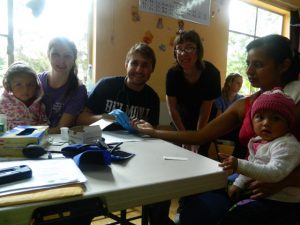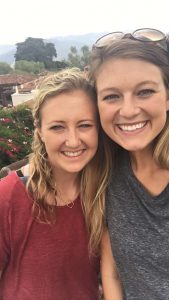

 The 2nd edition of the “Concepts in Pharmacogenomics” textbook from the American Society of Health-System Pharmacists was recently released, and Belmont College of Pharmacy Faculty Members Drs. Amy Ham and Dr. Scott Weston, along with Belmont Pharmacy alumnus Dr. Ali Roberts, contributed chapters.
The 2nd edition of the “Concepts in Pharmacogenomics” textbook from the American Society of Health-System Pharmacists was recently released, and Belmont College of Pharmacy Faculty Members Drs. Amy Ham and Dr. Scott Weston, along with Belmont Pharmacy alumnus Dr. Ali Roberts, contributed chapters.
Monthly Archives: May 2017
Mission to Cambodia: Hope Hospital and Preparing for Poipet
By Tessa Collier, Undergraduate Nursing Student
Today, the undergraduate nursing students went back to Hope Hospital here in Phnom Penh while the graduate nursing students went on home visits in the area. This morning eleven students and our three professors piled into the hospital van with several huge, military green duffel bags full of supplies to donate to the hospital. Dr. Massie led a Memorial Day themed devotion en route. When we arrived, we walked into the lobby to take a group photo with all of our donations. I have noticed that so many people want to take photos with us, and I have not encountered that on previous study abroad and mission trips I have been on.
Our group of eight students split into two, and we were led on a tour of the hospital. We were informed that Hope is known throughout the country for providing excellent care, and Cambodian nursing students love having the opportunity to learn at the hospital. Our guide explained to us how the hospital used to take pride in providing completely free healthcare to its recipients but decreased funding has forced it to start charging (albeit minimally) for services. We were led through the different departments, such as the Emergency Room, a minor procedure room, and Radiology. These are among the few of the only air-conditioned rooms in the entire facility. Instead of indoor waiting rooms, patients wait outside because the sun kills Tuberculosis. We walked through the beautiful courtyard with a large mango tree into a clinic and the lab. We finished our tour by visiting the medical and surgical wards on the second floor. Each ward has about 12-13 beds; there are no individual patient rooms. If a patient needs privacy while a procedure is performed, curtains are pulled around his/her bed. There are no patient care techs or nurses aides. Family members help move the patient from stretcher to bed and are taught by the nurses how to help in managing the care of the loved one. Coming to this hospital also makes me realize how much we waste in America’s hospitals. They do not dispose of chest tubes or other small things that we usually take for granted.
We dropped off five students to shadow local doctors and nurses. Two other students and I followed Dr. Massie, Dr. Taplin, and Dr. Wofford to the medical and surgical wards to look at charts. Charts here are still done through card copies. Dr. Taplin told us that every hospital in the country is required to chart in either English or French (two of Cambodia’s official languages, after Khmer); this particular hospital uses English because it was founded by English speakers. In the medical ward, Dr. Taplin opened the chart of a patient with abscesses in his spleen. They had found growths of what are called Burkholder’s pseudonomas (a term that was not even in Stedman’s Medical Dictionary) which is a type of bacteria common to this region. We then looked at the chart of another patient with Cirrhosis who had come to the hospital with ascites, which is fluid that has shifted into the abdomen. The doctors had just finished performing a paracentesis, draining 1.5-2 liters of fluid from the man (this is the maximum amount that can be drained per day.
We then went to the surgical ward where Dr. Taplin went over the chart of a woman who underwent a mastectomy to remove a huge tumor that had been growing for three years. She had not had access nor the education to wellness check-ups or cancer prevention that we have in the States. At this point, the woman was put on palliative (comfort) care because there is nothing more that can be done for her. There is no chemotherapy in this country. People who have the money can go over to nearby countries, such as Singapore, for treatment, but for the poor there is no such luxury. Dr. Taplin, Dr. Massie, and Dr. Wofford led the three of us students in a discussion about how care differs in this country compared to the States. Again, this hospital is known for providing quality care. So while there are many differences between the two systems, just because they do things differently here does not necessarily mean that it fails to provide great care to patients. It was a very informative and thought-provoking discussion.
We later regrouped with the other five students and went to lunch at Flavours Restaurant, where we went for dinner our first night here. We are now preparing for our nine-hour drive to a province called Poipet tomorrow where we will set up clinics.
Mission to Cambodia: “The Killing Fields”
Many people in many different countries around the world have been affected by genocide. When most people think about genocide they think about World War II and the Nazi’s decimation of Jewish people. Many people think that genocide is a thing of the distant past, but in Cambodia it is all too recent. From 1975 to 1979, only 38 years ago, Cambodia was thrown into chaos, by a radical regime, the Khmer Rouge and their leader, Pol Pot. Pol Pot saw hardships faced by people living in provinces outside the cities and blamed it on the people living inside the city. He saw education and wealth as a selfish and destructive nature that needed to be eliminated. Yesterday myself and others on the trip visited a cite where his radical ideas became a reality, and what a disgusting and horrific reality it was.
Upon arriving, the first thing you notice is an articulate archway, created in the traditional Cambodian fashion, as well as a tall building built with the same beautiful architecture, about 100 yards away from the entrance. After we walked inside the camp we dawned our headsets and began the audio tour. Another student on the trip, David, explained an interesting view of this after the tour stating that it felt odd to him that we had the privilege to listen at our own leisure and pace while we were walking on the souls of thousands. As we walked towards the first checkpoint, we grew nearer to the large ornate tower in the center. As we came closer the beauty of the architecture fades away as you notice the thousands of skulls and bones displayed inside; it was truly perturbing.
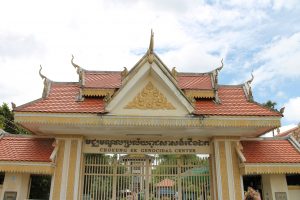
Entrance
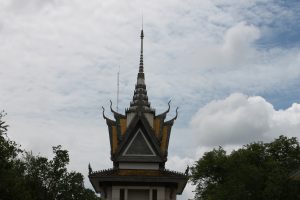
tower in center
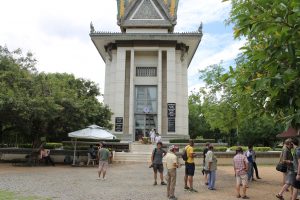
tower as we came closer
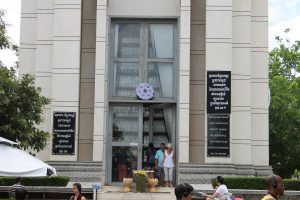
I won’t go into every detail of the audio tour, as it would take up too much time and my memory would not do it justice. As I began to walk around one of the things I noticed was birds singing and wildlife in full bloom. It was an oddly peaceful and almost tranquil place to be; almost as if it were a place to meditate and relax.
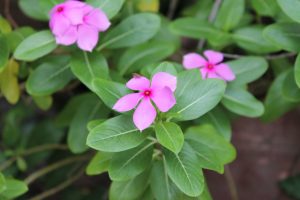
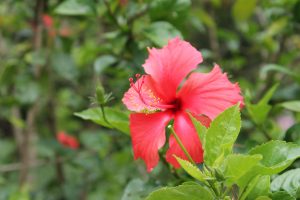
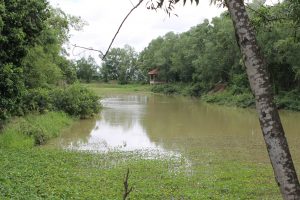
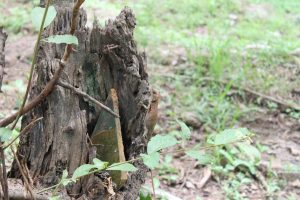
The path we walked and the audio tour portrayed a very different more terrifying realization. As you walk down the path there are sometimes fragments of bone and teeth scattered on the ground. There are dozens of pits and small mounds where mass graves had been excavated and the horrible reality hidden beneath brought into light for all to see. On the tour there were signs with descriptions of each area and recreated pictures of what the place was like while the killings were happening. Death and despair was everywhere and you could feel it.
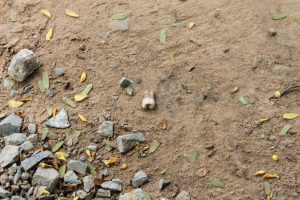
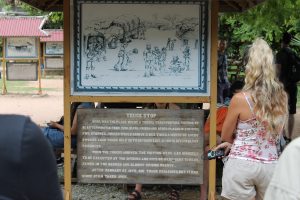

The mass graves have been decorated by tourists with bracelets as a sign of respect and sorrow for the victims, two places in particular had many bracelets; the mass grave of women and children and the child killing tree.
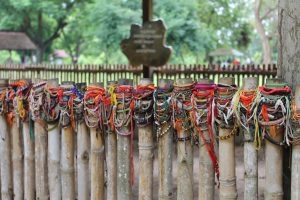
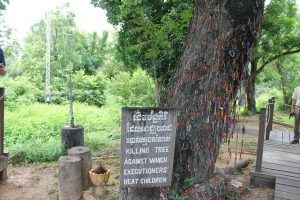
As the tour moves on. It brings you to a tree titled “The Magic Tree” that is explained to be the same species of tree under which Buddha found enlightenment. However this specific tree is ironically called this and was used to hang tools of massacre as well as lights and speakers that blasted revolutionary music to drown out the screams of agony. The audio tour provided a music clip of the music combined with a diesel generator recreating the noise the victims last heard. This was the hardest part of the tour for me and many others. The noise was terrifying and seemed to bring up the emotions of the anguished souls. There are no words to describe the feeling.
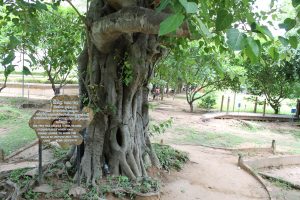
At the end of the tour we were allowed to visit inside the tower, I think it was called the Shtupa but don’t quote me on that. As we entered, we took off our shoes out of respect and were offered to buy incense or flowers to leave for the memorial. Inside the tower were many skulls and bones as well as the killing tools. Each skull had a different marking describing how they were killed.
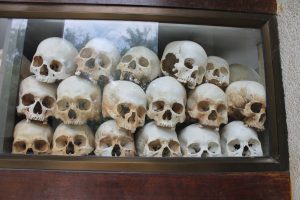
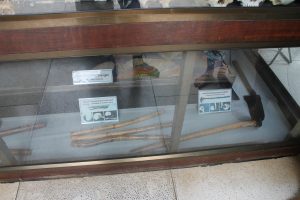
This place is rough on the conscience and for religious people can be a place of questioning. If there is a God how could he let this happen? How can the world be so cruel if there is an almighty? Many people would answer different things, but none of them can take away the heaviness of the reality. After leaving this place I felt I will never be the same. It is hard to go on living the privileged way we do when you know there was and still is so much hardship for others. This place and this country makes me feel ashamed of my fortune and ashamed of my trivial worries. There is nothing left to do but give back as much as I can and try to better myself and the people around me one action at a time. Let this place be a reminder to all of the terrible possibility of genocide. It could happen anywhere, but when the time comes we must make an effort to prevent catastrophes like this to ever happen anywhere.
Mission to Cambodia: Freedom’s Promise School Clinic
Today (Thursday, 5/25) was the fourth day of our trip, but with travel was our second full day in Phnom Penh, Cambodia! After spending yesterday exploring the city and learning more about the history, we were going to engage in the community around us through a variety of ways. Following breakfast at the hotel, our group of fifteen split into three different groups. One group went with a Social Worker to do HIV home visits and another group went to a local hospital to assist with check-offs for their staff. The group I was with was six of us going to a local school through the organization Freedom’s Promise. At the school we would be holding a clinic for Well Child Checks.
As we arrived in the area with the school, the van dropped us off across the street and walked through a small street, similar to an alleyway. The bleak reality of these peoples’ living conditions shook me. Small rooms, which consisted of little more than dividing walls and a cover were homes for families. Running water and simply a place for trash were non-existent. After walking along the row of homes, we were then in the area with the school. It consisted of several classrooms, an office, and a library. A teacher directed us to their covered play area with tables and chairs to use for our clinic. Lauren and I, both nursing students, set up to do height, weight, vital signs, and an eye chart. The two Doctorate of Nursing students, Kim and Paige did thorough assessments. Dr. Wolford and Dr. Massie were assisting anywhere and everywhere – from aiding in assessments to helping prescribe to keeping kids entertained as they waited.
A health issue noticed in nearly every child was tooth decay. This may seem somewhat insignificant to us and an easy fix, but for these kids it can be so much more. If further decay occurs, they could end up without teeth or an infection. While the United States has fluorinated water to help prevent this, these children come from families without running water (and Cambodia’s water isn’t drinkable, much less fluorinated). For the most part, brushing their teeth isn’t a priority. A toothbrush here costs $1, which seems insignificant to us. Yet, for many of these families, that is a day’s wages – not to consider the need for toothpaste or the lack of access to clean water. This simple issue made me realize even further how we take so much for granted back at home.
Dr. Wolford, a pediatric nurse practitioner, made an important point at the beginning of the day. She said that “Kids were kids, wherever you go.” This simple statement eased some of the nerves about not speaking the same language, as I found this reminder to be so true. Smiles, laughter, and even many games are so universal. Even if it was after a little misunderstanding, we learned their games as they did cartwheels over a string made w ith rubber bands. They learned limbo and we played their version of jump rope. As they waited for the next part of the assessment, Lauren and I were taught some of the shapes in Khmer. We sang “Head, Shoulder, Knees, and Toes” and taught some boys how to flip a half full water bottle to make it land correctly and cheered after many attempts for each of us. These kids were full of joy, despite their circumstances and I think that was the most powerful part of the entire experience.
ith rubber bands. They learned limbo and we played their version of jump rope. As they waited for the next part of the assessment, Lauren and I were taught some of the shapes in Khmer. We sang “Head, Shoulder, Knees, and Toes” and taught some boys how to flip a half full water bottle to make it land correctly and cheered after many attempts for each of us. These kids were full of joy, despite their circumstances and I think that was the most powerful part of the entire experience.
Mission to Cambodia: First Day
Today was my first day in Cambodia. My group and I woke up early, had breakfast, and walked through the city to the river. Most notably it was hot, and I sweated a lot. The city was pretty and the people were nice, so that made the heat slightly more bearable. Later on in the day, I went with a group to visit the S-21 prison museum. S-21 was first a school before the Khmer Rouge took power. The Khmer soldiers decimated the school and turned it into one of many torture camps used by the Khmer Rouge during the Cambodian genocide. Their prisoners were held in hardly livable conditions, tortured daily, then killed slowly and painfully after they had given confessions to crimes they never committed. In each of the buildings, there were pictures of the prisoners and the cells they lived and died in. The whole experience was hard to swallow, but I forced myself to look at the pictures, the torture devices, and the bones of the prisoners. I forced myself because it’s easy to look away, to not think about it and forget it happened – especially to an American. However, I see it as the least I can do for the people who can’t look away, and who can’t forget no matter how hard they try. They people who died there had no rights, no freedom, and no say in what happened to them, but I believe they have a right to be remembered; and I believe that it is our duty to remember them and the injustice of the Khmer Rouge so that those injustices will not be repeated. I think S-21 is a perfect example of what the Khmer Rouge did to Cambodia: destroy education, replace it with misery and death, and then leave it to be forgotten. There was a monument constructed at S-21 declaring that the information there is the right and property of humanity as to not forget the cruelty we are capable of.
Pharmacy Student Named as Inaugural Thomas Hall Scholarship Recipient
 Eva Kisakye, a student in Belmont’s College of Pharmacy, was recently named as an inaugural Thomas Hall Scholar through Child Family Health International (CFHI), an NGO focused on global health initiatives. Dr. Thomas Hall is a respected leader in global health, having worked for more than 60 years on improving the health of low-resource countries, providing medical care across the world and working to strengthen global health systems.
Eva Kisakye, a student in Belmont’s College of Pharmacy, was recently named as an inaugural Thomas Hall Scholar through Child Family Health International (CFHI), an NGO focused on global health initiatives. Dr. Thomas Hall is a respected leader in global health, having worked for more than 60 years on improving the health of low-resource countries, providing medical care across the world and working to strengthen global health systems.
After a search that included nearly sixty applications, Kisakye was selected as one of the awards inaugural two recipients. A Ugandan native, Kisakye moved to the United States in 2008 to pursue her education. Passionate about community pharmacy, Kisakye will return to Uganda in October for a clinical rotation where she will work alongside mothers and children in an AIDS clinic, an opportunity she sought out and organized herself. The scholarship money will support Kisakye’s time in Uganda.
“I hope to become well-versed in ways to increase healthcare access in resource-limited settings while addressing healthcare disparities and social determinants,” Kisakye said. “Thanks again for giving me the opportunity to enhance my knowledge and clinical experience in public health while serving the people of Uganda.”
CFHI’s Executive Director said, Dr. Hall is a fearless advocate for the prominent position of young people in global health education, research, and practice. We are honored to support Dr. Hall’s vision and expand his impacts.
The recipients’ selection represents the end of a nationwide search for two future leaders in global health and a new step forward in Child Family Health International’s passion for training individuals in a setting that establishes industry standards in ethics and patient safety.
Mission to Guatemala: Last days
 Today, the nursing/pharmacy team had the privilege of traveling to a prominent coffee plantation and offering a hand. We focused on providing health screenings and education to the plantation workers and their families. We were also able to hand out dental hygiene kits to all the individuals we crossed paths with. One thing that we have really learned on this trip is the value of teamwork. The nursing students, pharmacy students, and a Guatemalan doctor all worked hand in hand to provide this community with access to healthcare. We also got the opportunity to see how this plantation prepares their coffee products. Now not to brag, but if this healthcare stuff does not work out, some of us may have a future in the coffee industry. The highlight of our day was definitely towards the end. As we were passing the horse stables, we saw one of the young boys we had seen on day 1 of this trip. When we first saw him, he was the picture of discomfort and pain. Today, when we asked him how he was feeling, he responded with the biggest smile and an endless amount of gratitude. This was a reminder that all our hard work here was making a difference.
Today, the nursing/pharmacy team had the privilege of traveling to a prominent coffee plantation and offering a hand. We focused on providing health screenings and education to the plantation workers and their families. We were also able to hand out dental hygiene kits to all the individuals we crossed paths with. One thing that we have really learned on this trip is the value of teamwork. The nursing students, pharmacy students, and a Guatemalan doctor all worked hand in hand to provide this community with access to healthcare. We also got the opportunity to see how this plantation prepares their coffee products. Now not to brag, but if this healthcare stuff does not work out, some of us may have a future in the coffee industry. The highlight of our day was definitely towards the end. As we were passing the horse stables, we saw one of the young boys we had seen on day 1 of this trip. When we first saw him, he was the picture of discomfort and pain. Today, when we asked him how he was feeling, he responded with the biggest smile and an endless amount of gratitude. This was a reminder that all our hard work here was making a difference.
 The PT/OT team spent our last workday back at Keramion, the school for special needs children that we visited on Monday. The day began with a bit of dancing, followed by receiving gifts from the children. We were so amazed by the generosity that we were shown and will treasure the gifts as well as the hugs we were given. Afterwards, the OT team saw one more child with autism who had some behavior issues that the mother and teachers wanted to discuss. We were able to provide education on different calming strategies such as deep pressure, bouncing on a ball, and slow swinging. His mom was present and was really interested in learning, and some of the other OT team members also had the chance to interact with child’s younger sister. Following this, the PT and OT students set up a small obstacle course for the children. Due to rain, we had to move it inside, but it still worked! The staff was excited to learn about new ways to engage the children in purposeful play that would encourage practicing different skills such as crawling, jumping, and grasping various objects.
The PT/OT team spent our last workday back at Keramion, the school for special needs children that we visited on Monday. The day began with a bit of dancing, followed by receiving gifts from the children. We were so amazed by the generosity that we were shown and will treasure the gifts as well as the hugs we were given. Afterwards, the OT team saw one more child with autism who had some behavior issues that the mother and teachers wanted to discuss. We were able to provide education on different calming strategies such as deep pressure, bouncing on a ball, and slow swinging. His mom was present and was really interested in learning, and some of the other OT team members also had the chance to interact with child’s younger sister. Following this, the PT and OT students set up a small obstacle course for the children. Due to rain, we had to move it inside, but it still worked! The staff was excited to learn about new ways to engage the children in purposeful play that would encourage practicing different skills such as crawling, jumping, and grasping various objects.
The children headed home after completing the obstacle course so that the afternoon could be used for a staff in-service. Griselda, the school’s founder, also shared more of her incredible testimony with us, and we were able to pray for her which was a very moving experience for everyone involved. The PT students on the team also worked with Griselda on different exercises and were able to give her advice on managing her back pain. It was amazing to see how much she had improved in only a few days! For lunch, Belmont team members treated the staff to spaghetti, and the rest of the day was spent training the staff on specific topics such as sensory integration, proper lifting techniques, and behavior management. All of the staff members were extremely grateful for our help this week. After spending so much time together, it was hard to say goodbye, but we know that the children are in good  hands at Keramion and that God is definitely at work there. It was such a blessing to bear witness to this incredible ministry this week.
hands at Keramion and that God is definitely at work there. It was such a blessing to bear witness to this incredible ministry this week.
Written by: Anais, Emily, Alicia, and Hope
Mission to Guatemala: Mother’s Day
Today was Mother’s Day which is a major holiday in Guatemala as many of the mothers had the day off work. We wanted to help serve the community by helping them prepare for the special celebration. We enjoyed helping the students decorate and pick flowers from the field for the mothers. The PT/OT team also supported the nursing and pharmacy students stepping in as needed to assist with orthopedic and musculoskeletal concerns. We worked as a team to identify the proper professional needed for each case. The PT/OT team also spent the afternoon preparing educational materials for the upcoming day tomorrow.
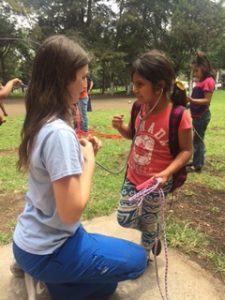 Today, the nursing team primarily focused on mothers and children, with cultural perspective seeming to be the theme of the day. Because there was such a high number of mothers and children seen there were several things that we realized that we never noticed before. One was the relative age of mothers. Today we had a mother who was 19 with two children. This provided a dose of perspective as several members on the team are around this age and could not even imagine being in her shoes. It was also shocking to realize how access to care differs from America. Back home, if we have a concern with a child we can just drive to a clinic; however, here in Guatemala mothers showed up from all around carrying babies on their backs knowing that we were the only resources they had access to. It was eye-opening and humbling to see how far these women came just for us to get the opportunity to care for them.
Today, the nursing team primarily focused on mothers and children, with cultural perspective seeming to be the theme of the day. Because there was such a high number of mothers and children seen there were several things that we realized that we never noticed before. One was the relative age of mothers. Today we had a mother who was 19 with two children. This provided a dose of perspective as several members on the team are around this age and could not even imagine being in her shoes. It was also shocking to realize how access to care differs from America. Back home, if we have a concern with a child we can just drive to a clinic; however, here in Guatemala mothers showed up from all around carrying babies on their backs knowing that we were the only resources they had access to. It was eye-opening and humbling to see how far these women came just for us to get the opportunity to care for them.
Written by: Kristin & Dylan from nursing and Lexi & Maggie from PT/OT
Mission to Guatemala: Teamwork
 TEAMWORK was the word of the day. Today both the OT/PT and Nursing/Pharmacy teams went to a coffee plantation with a school attached. Nursing and Pharmacy set up a health screening station similar to yesterday where they checked blood pressure, blood glucose, and height/weight. We assessed their needs for any medications and the doctor was able to write prescriptions. For example, one coffee worker came in for a screening and stated there were no complaints. When the nursing team found out he was having knee pain, the physical therapists were brought in to show him exercises for strengthening and explain why those would be beneficial. He was very grateful because he could apply what he learned to his everyday work. In addition, while performing a health screening on a mom and her son, nursing noticed that the son was having difficulty with using his hands. Occupational therapy was brought in to do a short assessment with the son and he was given a bag of toys to take home with him to work on his fine motor skills and radial-ulnar dissociation. He was overjoyed and thankful for the toys that he could call his own.
TEAMWORK was the word of the day. Today both the OT/PT and Nursing/Pharmacy teams went to a coffee plantation with a school attached. Nursing and Pharmacy set up a health screening station similar to yesterday where they checked blood pressure, blood glucose, and height/weight. We assessed their needs for any medications and the doctor was able to write prescriptions. For example, one coffee worker came in for a screening and stated there were no complaints. When the nursing team found out he was having knee pain, the physical therapists were brought in to show him exercises for strengthening and explain why those would be beneficial. He was very grateful because he could apply what he learned to his everyday work. In addition, while performing a health screening on a mom and her son, nursing noticed that the son was having difficulty with using his hands. Occupational therapy was brought in to do a short assessment with the son and he was given a bag of toys to take home with him to work on his fine motor skills and radial-ulnar dissociation. He was overjoyed and thankful for the toys that he could call his own.
The kids at the school were preparing for Mother’s Day tomorrow, which is a huge holiday here and the kids were excited to make crafts for their “madre”. The kids split into groups and made necklaces bracelets with beads and a card with flowers and a special message to their mom. After this activity, the kids were excited to play outside with jump ropes, soccer and parachutes. The team noticed how much joy and happiness the kids had on their faces and in turn how much joy and happiness they brought to each one of us.
Even though there was a language barrier, the interpreters were very helpful and greatly appreciated. While there was difficulty finding interpreters who were willing to take off work from their daily jobs to help, there were a few who were gracious enough to fill the need. Along with an interpreter, a few people on the team taught CPR for adults and infants as well as the Heimlich maneuver to the adults and high school students. The parents were grateful for this education and were able to practice on the mannequin.
As we performed screenings, played outside with the kids, and did arts and crafts, every one of us on the team was amazed by the joy and love we received from them. Our work is truly appreciated and we can’t wait to go back again tomorrow to help celebrate Mother’s Day!!!


Adios for today from Guatemala!
Maria (PT), Hope (OT) and Allison (Nursing)
Mission to Guatemala: Our first day
 Buenas Noches!! We successfully completed our first day of clinics here in Antigua, and wow was it humbling. The nursing/pharmacy students had the privilege of caring for around 50 students at a local school on a coffee plantation here in town. We set up a pop-up clinic that assisted a Guatemalan doctor providing physicals and basic health screenings for children and their mothers. Although today might not have gone according to our “perfect” schedule, we used today as a learning experience to remind ourselves that God’s perfect plan does not always align with our ideal plan. As a team, we learned that even though our treatment plans may have felt insufficient to the need we were trying to fulfill at the time, our love was sufficient and the Lord’s presence was there. A team member, while providing care, saw this first hand. She was observing a student who was young and just appeared sad and scared. She noticed that the student had been looking at her stethoscope with curiosity so she went and asked if the student would like to listen to her heart. The second the student began to listen her whole demeanor began to change. Her face lit up and she said “Corizone boom boom”. She continued to listen to other body sounds smiling the entire way. Through this encounter, it became apparent that healing is not only physical, it is more so emotional and spiritual, and although we do not have the resources to heal every single medical issue, we do have the capacity to show love and heal spiritually and that is in some cases even more valuable than fixing a physical issue.
Buenas Noches!! We successfully completed our first day of clinics here in Antigua, and wow was it humbling. The nursing/pharmacy students had the privilege of caring for around 50 students at a local school on a coffee plantation here in town. We set up a pop-up clinic that assisted a Guatemalan doctor providing physicals and basic health screenings for children and their mothers. Although today might not have gone according to our “perfect” schedule, we used today as a learning experience to remind ourselves that God’s perfect plan does not always align with our ideal plan. As a team, we learned that even though our treatment plans may have felt insufficient to the need we were trying to fulfill at the time, our love was sufficient and the Lord’s presence was there. A team member, while providing care, saw this first hand. She was observing a student who was young and just appeared sad and scared. She noticed that the student had been looking at her stethoscope with curiosity so she went and asked if the student would like to listen to her heart. The second the student began to listen her whole demeanor began to change. Her face lit up and she said “Corizone boom boom”. She continued to listen to other body sounds smiling the entire way. Through this encounter, it became apparent that healing is not only physical, it is more so emotional and spiritual, and although we do not have the resources to heal every single medical issue, we do have the capacity to show love and heal spiritually and that is in some cases even more valuable than fixing a physical issue.
At the same time, the physical therapy and occupational therapy team was over at the school for disabled children called Keramion. We started off getting to learn a lot about the school and the teachers that are devoting their lives to help these children. This staff was incredible and so welcoming of the team. Everyone was greeted with a big hug and a such a genuine smile! Griselda, the founder of the school, was so open in telling us her testimony and all she’s gone through to make Keramion an awesome environment for these kids to learn and grow. After meeting the kids, the team split up according to their specific needs and evaluated each child to assess where they are in their development. The staff members were very grateful for ideas that the mission team had given them on past trips and we’re hoping to give them more suggestions to continue the progress they are already making! While a lot of our day consisted of evaluating and utilizing what we have learned in school, a great portion of the day involved playing, interacting, and loving on the kids. A definite highlight of the day was coming back from lunch to everyone singing, dancing, and praising Jesus. We had so much fun brainstorming games for the kids to play that will also help their therapy progress! After all the thanks we received, we couldn’t help but feel equally blessed by the staff and kids of Keramion and we are so excited to go back on Thursday!
Adios from Guatemala!
Kendall & Macey from PT (in the picture below), Kristin (not pictured) & Brooke ( back row right in the picture above) from nursing
Tennessee Health Care Hall of Fame Announces 2017 Inductees
Hall of Fame’s third class represents Tennessee’s greatest health and health care pioneers
With a mission to honor men and women who have made significant and lasting contributions to the health and health care industries, the Tennessee Health Care Hall of Fame announced the six health care professionals selected as the Hall of Fame’s 2017 class at a luncheon on Belmont University’s campus today. Created by Belmont University, the McWhorter Society and Founding Partner the Nashville Health Care Council, the Hall of Fame will induct these individuals at a ceremony in October.
President of the Nashville Health Care Council Hayley Hovious said, “This impressive group of inductees represents some of our state’s greatest talent. With individuals from all across Tennessee who have made a significant impact on their communities through their work as leaders, politicians, practitioners, scientists, philanthropists and innovators, the Hall of Fame is honored to induct such a deserving group of health care heroes.”
The nomination process began in January and was open to practitioners, executives, entrepreneurs, mentors, teachers, scientists, researchers, innovators or any person with a connection to the health or health care field. Nominees must have:
- Been born, lived or have worked in Tennessee
- Made a significant impact and lasting contribution to health care at the local, state, national or international level
- Exhibit the highest ethical and professional character
- Serve as an outstanding role model in their community
Among the more than 30 highly qualified nominees, inductees were chosen by a Selection Committee made up of health and health care leaders from across the state. Selected inductees represent some of Tennessee’s greatest health and health care pioneers, leaders and innovators.
The 2017 inductees include:
- Dr. Dorothy Lavinia Brown: First African American female surgeon in the south, TN House of Representative and General Assembly Member, Longtime educator and Chief of Surgery at Riverside Hospital and Clinical Professor of Surgery at Meharry, Advocate for women’s health, rights and education
- Dr. William “Bill” Frist: Former U.S. Senator and Majority Leader, Vanderbilt Transplant Center founder, First heart and lung transplant surgeon at Vanderbilt, Founder of Hope Through Healing Hands and NashvilleHealth, Senior Fellow at the Bipartisan Policy Center
- Joel Gordon: 47-year health care veteran who introduced physician ownership/joint ventures as a business structure, Founder of GeneralCare and Surgical Care Associates, Co-Founder of HealthWise of America, Owner of Gordon Group Investment Management
- Dr. Harry Jacobson: Physician, entrepreneur and investor who founded/co-founded eight companies, Past Chair of the Nashville Health Care Council Board of Director, Executive-in-Residence at Belmont University’s Jack C. Massey College of Business, Past Vice Chancellor for Health Affairs at Vanderbilt University and former CEO of Vanderbilt University Medical Center
- Dr. Stanford Moore: Received the Nobel Prize for Chemistry in 1972 for his work with proteins and their composition which led to the first understanding of the complete chemical structure of protein and ultimately informed decades of scientific work surrounding disease and drug discovery; Graduate of the University School of Nashville and Vanderbilt University
- Dr. Donald Pinkel: First Director and CEO of St. Jude Children’s Research Hospital; Received the Lasker Award for Medical Research, Kettering Prize for Cancer Research and Pollin Prize for Pediatric Research; Led the development of the first treatment for childhood acute lymphoblastic leukemia, increasing the cure rate from 4 to 50%.
In addition to recognizing Tennessee’s most influential health and health care leaders, The Hall of Fame will serve as an on-going educational resource to document the rich history that has contributed to Tennessee’s position as a leader for national health care initiatives.
Belmont’s President Dr. Bob Fisher said, “One of the things I am incredibly grateful for is Belmont’s placement in Tennessee – a state that is widely recognized as a central hub for health care in the United States, with Nashville at the helm. Our community continues to see the efforts of so many as individuals and organizations take significant strides towards shaping and advancing the health and health care industries. Meanwhile, Belmont continues to play an increasingly significant role in undergraduate, graduate and executive health care education. The induction of these six health care legends, and those that will come after them, will help Belmont inspire the next generation of health care greats, while further promoting our state’s booming success as the nation’s premiere health care hub.”
Created in 2015, the Hall of Fame has previously inducted 14 members including Jack Bovender, Dr. Stanley Cohen, Dr. Colleen Conway-Welch, Dr. Thomas Frist, Jr., Dr. Thomas Frist, Sr., Dr. Henry Foster, Dr. Ernest Goodpasture, Dr. Frank Groner, Jack C. Massey, R. Clayton McWhorter, Dr. David Satcher, Dr. Mildred Stahlman, Dr. Paul Stanton and Danny Thomas.

